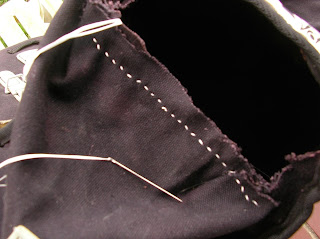Too bad.
I believe that I should know how to repair and maintain as much of my stuff as I am able to. Not to cheat the manufacturers out of another buck (though that's certainly a good reason), but to be the master of my stuff. If I can repair it, it will last longer, and I will understand a little more of how it works.
My mother (z"l) taught me how to hand-sew when I was very young, no more than five or six. And since then, I've mended lots of my own clothes, bags and blankets; and even sewn a couple of quilts.
Here's a quilt I finished in the spring of 2000.
I sewed the whole thing by hand, using one of my mother's old top sheets as the backing (I folded the sides in on top of the quilt as a border). I use this quilt regularly in the summer as a picnic blanket, and sometimes in the winter as an extra layer when I'm relaxing on the sofa.
Recently, I came into possession of a Carradice Camper Longflap saddlebag. The Camper is the largest transverse saddlebag Carradice makes. Constructed of waxed cotton and leather straps, it retails for around $150 new. The seller had spilled some battery acid inside the bag and burned some holes into the fabric; he had also removed the dowel and replaced it with his mini-pump. He sold it to me for less than a third of the reatail cost, a heck of a deal even if I had to fix it up. The bag came to me with no dowel, no straps to attach it to a saddle, and still feeling vaguely of batter acid residue mixed with wax.
I began to figure out how I would patch the bag; the acid had eaten away entire square inches of the bottom of the bag and part of one of the outside pockets as well. After turning it over and over, I decided I would patch the holes in the bottom, then reinfoce the areas around the holes with more stitching, and finally reconstruct the bottom and sidewalls where the outside pocket once attached. I also decided I couldn't save the bottom of the outside pocket, so I cut it awat and closed it up shorter. it would be asymmetrical, but functional.
For patching material, I used a Thomson stem bag, doubled up and hemmed underneath, from a stack of these I got last year.
After I'd gone this far, it occurred to me that perhaps it would be good to try and neutralize what remaining residue there might be. So I took the bag outside, and poured vinegar on the affected fabric. In a little while I'll boil some water and pour that over the area, and let it dry outside all day.
(It's waxed cotton, so I can't just toss it in the washing machine as was recommended by several sites.)
Then, once it's dry and I can continue mending it, I may add fabric inside to completely line the bag and keep any remaining residue from getting on whatever I carry. It's not a perfect solution, but it's better than doing nothing.
Admittedly the bag will look odd with Thomson logos covering the holes and reconstructing the sidewalls near the pocket. I have tons of this fabric, and it's pretty sturdy. So I think the liner will be made of the same material, several bags opened up and sewn together to make a large single panel that I can then trim and sew to fit as a lining.
I'll post my progress as the repairs near completion. If it works out I may eventually put this on the Bridgestone.







No comments:
Post a Comment